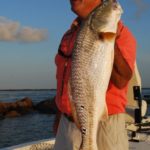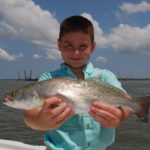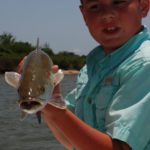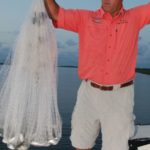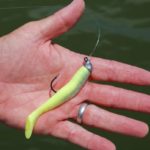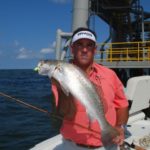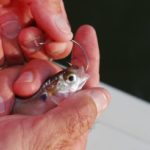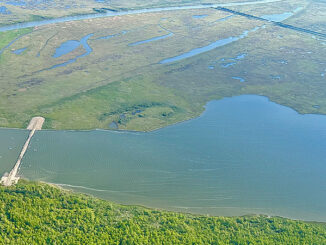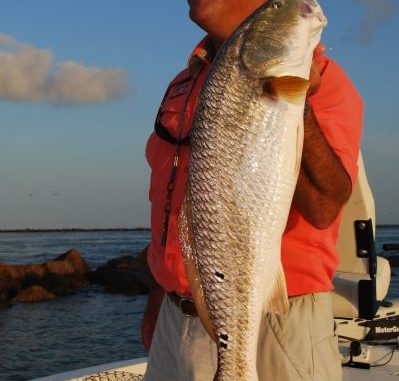
Big Lake proper still holds guppy trout in the heat of the summer, but here’s how this veteran guide — and his son — continue catching lunkers.
Ten-year-old Phillip Rue was scrunched up on the bow seat of the boat, torquing the handle of the spinning reel ferociously.
“Hoo hoo, I got one!” he shouted.
The reel’s drag screeched in protest as the fish on the end of the line struggled to escape.
When the 2-foot-long blacktip shark thrashed to the surface, the young man went ballistic.
“It’s a mako; it’s a mako. I think that it’s a mako!” he shouted.
His father, veteran Calcasieu Lake charter fishing guide Erik Rue, patiently unhooked the shark, and then told his son, “You got your wish. Now catch a speckled trout.”
“Nooo,” the youngster pleaded, “I want another shark.”
The trip began before daylight, when the older Rue pulled out of the canal at Hebert’s Landing into the lake. The lake’s breeze blew away the hoards of mosquitoes that had been peppering Phillip’s legs.
In the darkness, Rue jumped the boat up on step and headed southwest across the lake to the Calcasieu Ship Channel and then south.
“I love this time of the year,” he said, more to himself than anyone else. “Fishing is really good. I like it hot. I sweat like a pig, but I don’t mind.”
Rue reached the lower end of the lake before the sun peeped over the horizon. In the channel below the lake, he backed off the throttle and idled slowly southward, cast net in hand and eyes scanning the water for mullet heads dimpling its surface.
A few expert casts later, he had over a hundred finger-sized mullet in his livewell.
“On a weekend, it would be hard to stop and catch bait,” he explained as he cruised farther southward. “I‘d have to get down there to stake out a spot.”
By “down there,” Rue meant the ship channel jetties, the twin wall-like fingers of rock that line the Calcasieu Ship Channel out into the Gulf of Mexico.
The heat of summer means a shift in tactics for Rue. Simply put, it is to go south.
From mid-July into September, he said, the area from Long Point to the jetties is the main fishing area for better (meaning larger) speckled trout. The lake proper still holds lots of specks when the water is hot, he explained, but they are small.
Good fishing at the jetties was not a complete secret. The back side of the east jetty was already speckled with boats — and it was a Tuesday.
Rue swung the boat around the end and behind the jetty to join them. He used his trolling motor to quietly approach the rock wall, and gently lowered his grappling hook-style home-made anchor made out of steel rebar.
Rue tossed his hook-bearing offering inches from the rocks. His son imitated him, but wasn’t quite as accurate. They left their baits parked. They didn’t work them or retrieve threm.
One redfish, then another, then two more came over the rail. Rue only kept the 16- to 21-inchers, calling them “eaters.” The others were quickly released.
Phillip alternated between daydreaming and fidgeting. Dad was constantly coaching.
“Keep your rod down,” he advised. “Don’t move your bait. Keep your bait in the water.”
But this early in the morning, the boy seemed more interested in what his father was doing than in tending his own rod.
What his dad was doing was catching fish, wading through lots of reds for a few trout.
As the strong incoming tide began to slacken and he began to tire of the steady diet of redfish, Rue became restless.
His announcement that he would be picking up the anchor to run to the rigs offshore immediately brought young Phillip to life and produced an un-interruptable stream of chatter from the boy about catching sharks.
His eyes sparkled in anticipation.
Father Rue grinned broadly, and when his son finally paused, explained.
“He’s eat up with sharks,” the elder Rue said.
The boy grinned hugely, as if in confirmation.
Rue headed southeast, passing large numbers of mobile jack-up rigs, temporarily stacked there between jobs. These, he explained, will hold fish but are not his first choices.
After reaching his target — a large, permanent rig in 35 feet of water — Rue circled it slowly, studying his Lowrance split-screen fathometer carefully.
He tied off to one side of the platform, and offered the same fishing rig to these trout that he had been using at the jetties.
Neither of the pair got any action on their live mullet. Rue untied the boat and moved it to another corner of the rig. Same result.
“I am in disbelief that there are no fish here,” he muttered while untying the boat, which he then positioned to drift by the platform.
Throwing chartreuse Norton Bull Minnows on jigheads, he took two nice trout in three casts.
He was puzzled.
“I’ve seen where they bite on live bait but not artificials, but never on artificials instead of live bait,” he said. “They must be suspended off the bottom.”
He tied the boat off again, and started catching speckled trout mixed with Spanish mackerel on the plastic-tipped jigs.
On the bow, Phillip let out a howl. He was onto something bigger that jumped on his plastic. It was another shark, larger than the first one.
After his father released the brute, the youngster was near hyperventilating.
“That was fantastic! It was a great white. I am sure of it,” young Phillip said.
Rue iced a couple more trout before the 10-year-old latched onto another big fish. His face was twisted into a grimace, and the effort to crank the spinning reel handle contorted his whole body.
This one wasn’t coming in easily, so the elder Rue relieved his son on the rod. Phillip immediately grabbed the landing net and jumped all over the boat waving it like a combat weapon.
“This one is just a jack crevalle, son,” Rue explained. “Let me break him off.”
But the youngster would have none of it.
When finally the bright-yellow tail of the jack flashed at the surface, he shouted exuberantly.
“Yellowfin tuna; it’s a yellowfin tuna!” he said.
After the fish was released, young Phillip did a double fist pump in the air and proudly proclaimed, “I caught the biggest fish.”
With nothing to keep the trout interested during the commotion, the bite played out, and 11:30 a.m. found the anglers back at the jetties.
The tide had turned and was falling hard, so hard that the water was dirtied more than Rue liked.
His quick eyes however picked out a nice tripletail waffling cross-current near the surface on its big, wide side, like they are prone to do. A quick cast with plastic to the fish produced supper for later that evening.
As Rue tooled the boat northward in the ship channel, he explained that fishing in the channel is nearly 100 percent dictated by water quality — if it’s good, fish it; if not, fish somewhere else.
He stopped the boat at a point created by a meander of the old pass to the east out of the dredged channel. Current produced by the falling tide was splitting and sweeping over the point to either side.
It was what he called “a good falling-tide spot.”
Shortly after anchoring to cast into one side of the point, Rue picked up a nice trout, followed by a hookup by his son.
Soon the action heated up, with both catching specks up to 23 inches long.
After conquering man-eating sharks and yellowfin tuna, Rue had the boy’s attention and never quit coaching him on technique.
As for Phillip, he was babbling constantly with excitement. He cranked the spinning reel furiously to retrieve the big trout up-current, even with the drag screaming.
Often both of the father/son team had fish on at the same time.
After netting a fish for his father, Phillip looked back to his rod stabbed in a holder and saw it doubled over.
“Hey, I got one!” he hollered before promptly throwing the landing net overboard, barely within reach of a rod tip by his father.
“I didn’t want to lose that fish,” he explained, his dark eyes flashing.
After a few more fish, Rue sensed that they were pushing their limits and asked Phillip, “You had enough of it?”
“No. I am just getting started,” was the reply.
He puffed his little chest out.
“I’m going to take over my father’s business,” the 10-year-old said.
He thought a moment, and then added, “But, he can still work here if he wants to.”
Capt. Erik Rue is a featured angler in the book Trout Masters: How the Pros Do It, by Jerald Horst. Erik Rue’s Calcasieu Guide Service can be reached by calling 337-598-4700.
